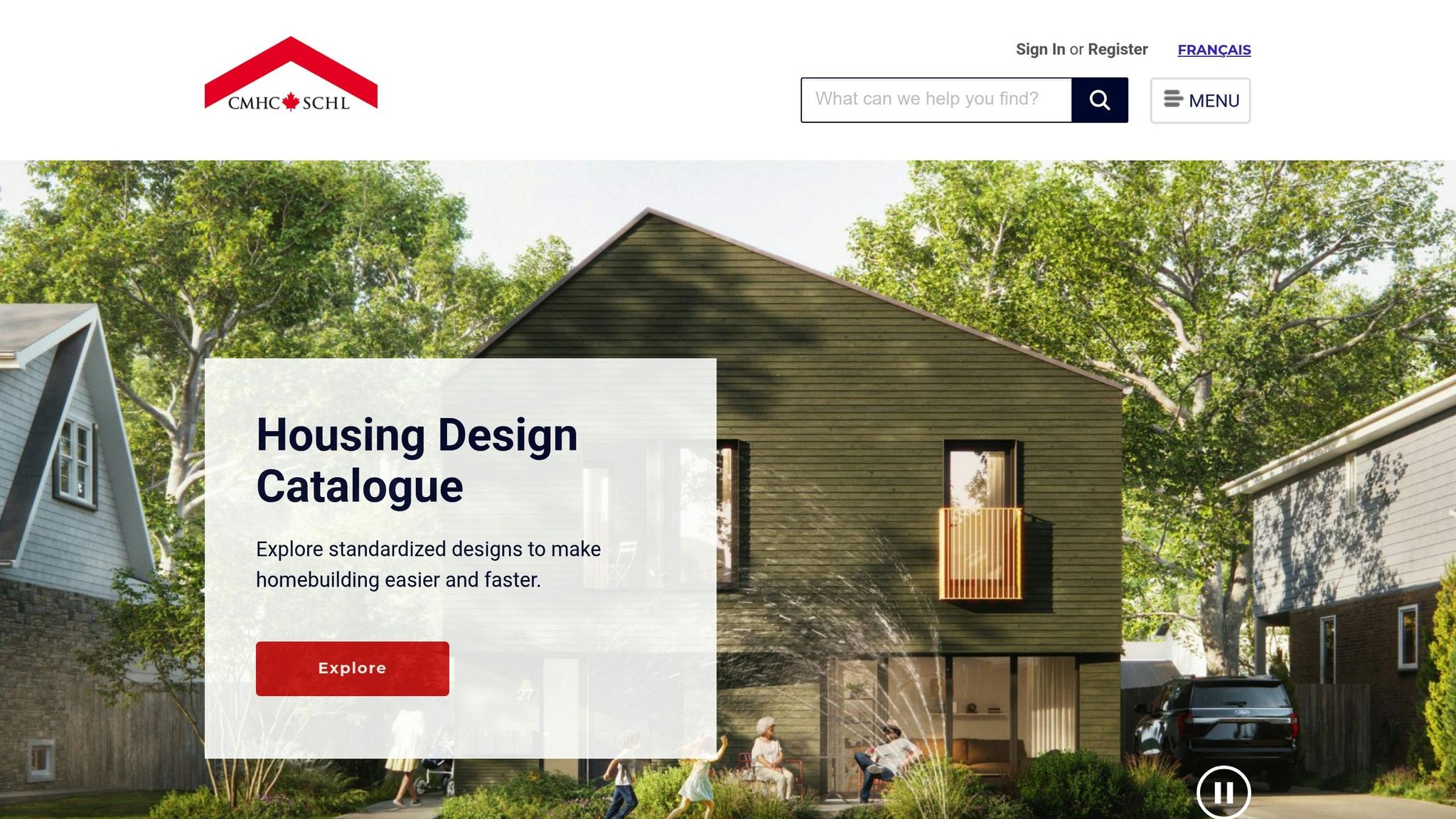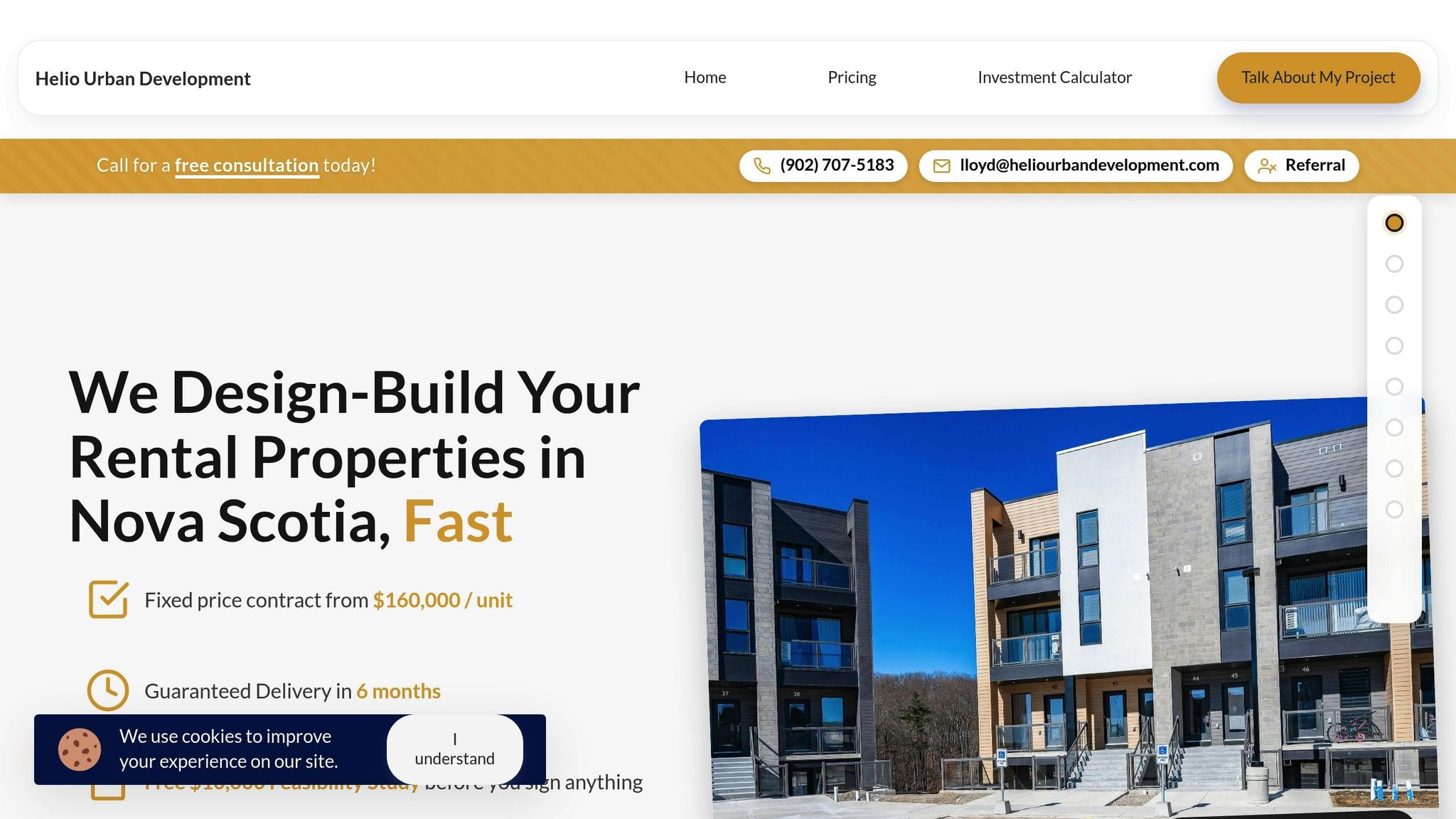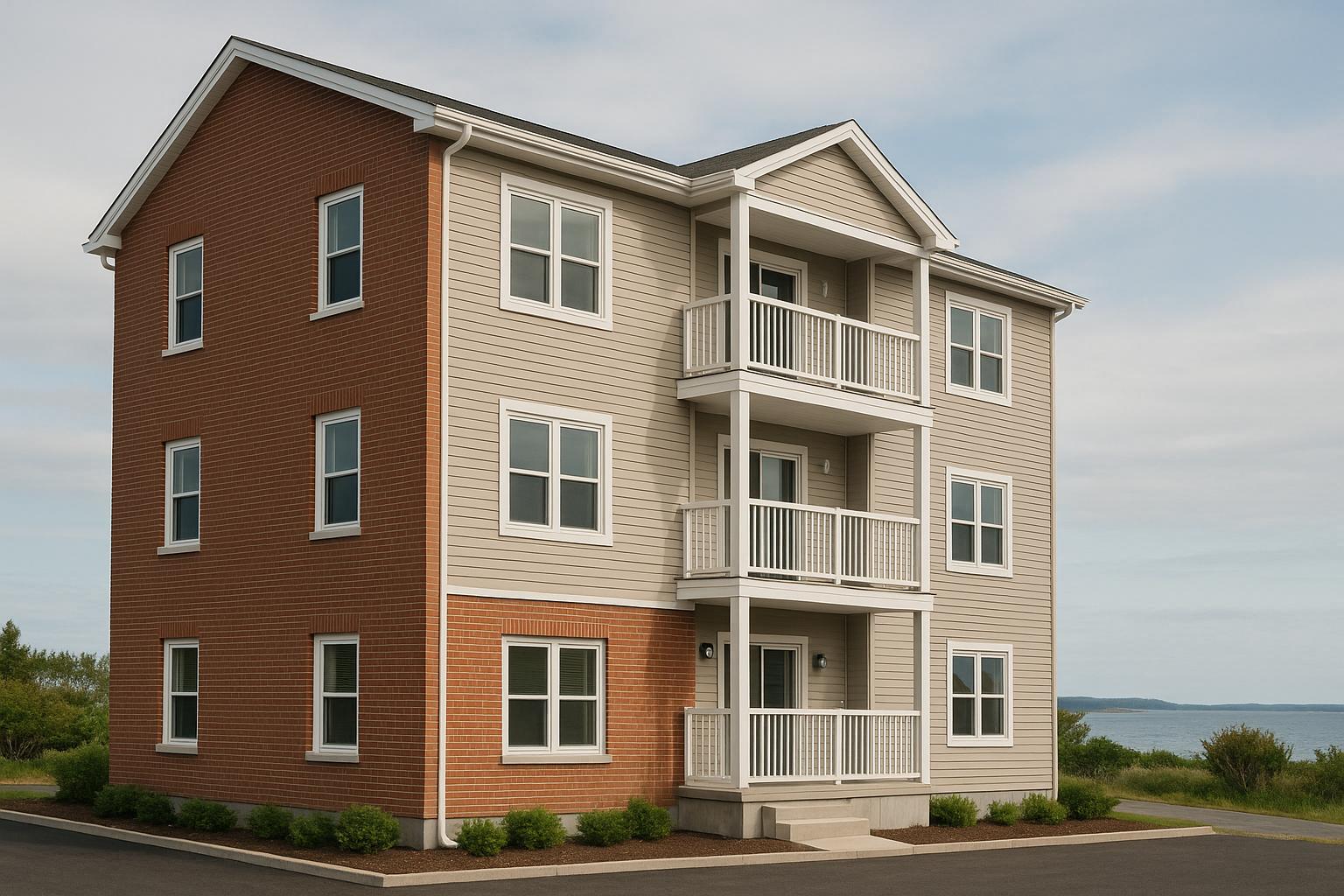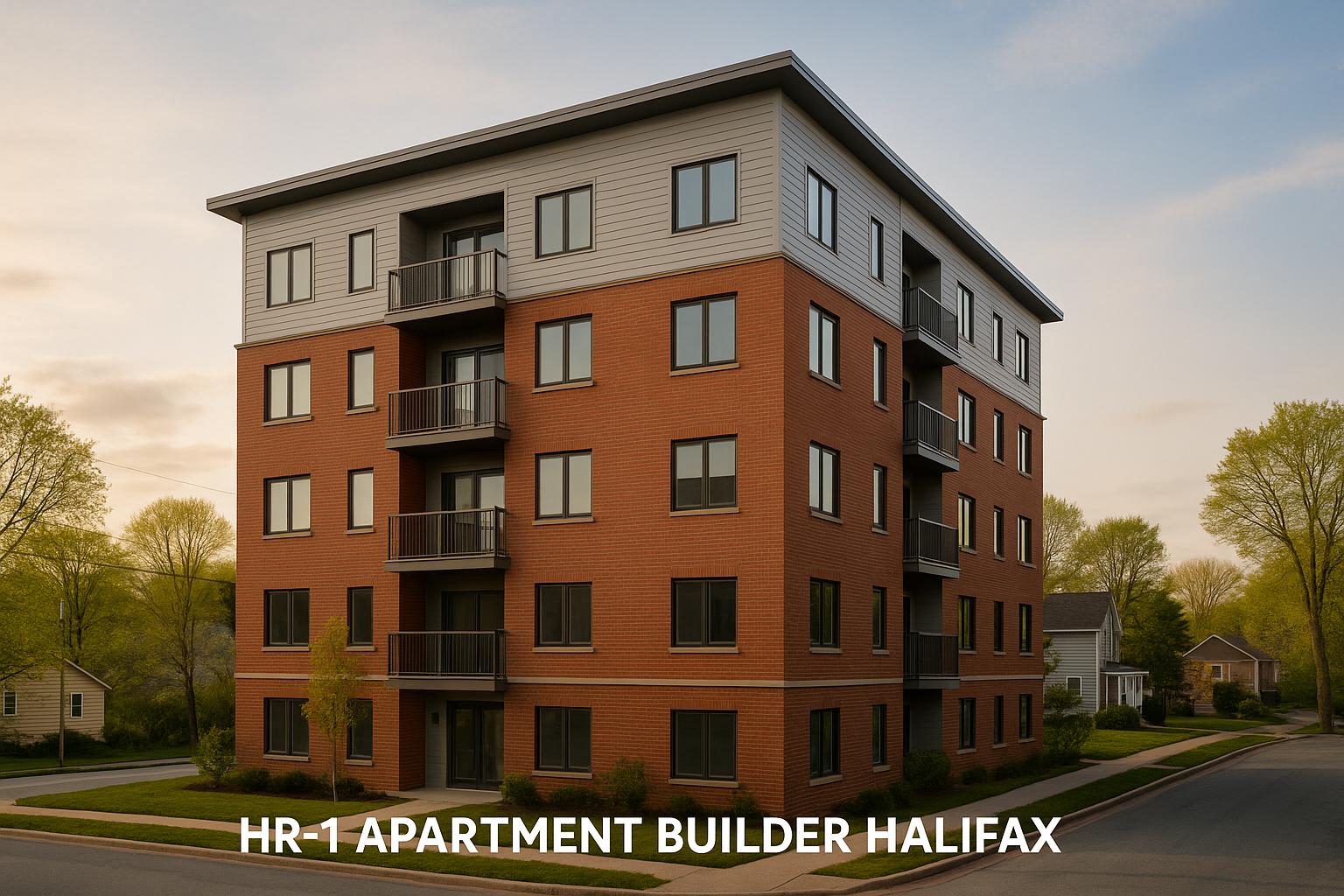Building a multi-unit rental property in Nova Scotia requires careful financial planning. Construction loans, unlike traditional mortgages, release funds in stages to match project progress but come with added costs like interest, taxes, and insurance before any rental income is generated. Understanding loan options, local financing factors, and the impact of interest rates is crucial to managing costs and maximizing returns.
Here’s a quick breakdown of what you need to know:
- Construction Loan Types: Options include standard construction loans, CMHC MLI Select loans (offering lower down payments and extended terms), and government grants or forgivable loans.
- Local Factors: Nova Scotia’s market varies by region, with Halifax seeing higher costs. Local lenders often offer flexibility, while programs like CMHC MLI Select require energy efficiency and affordability standards.
- Interest Rate Impact: Higher rates increase borrowing costs and reduce ROI. Fixed-rate loans provide stability, while variable rates carry risk during long projects.
- Reducing Risks: Lock in fixed rates, use integrated design-build services to avoid delays, and explore CMHC programs for better terms.
For smoother execution, consider working with integrated construction firms like Helio Urban Development, which simplifies processes with fixed pricing, guaranteed timelines, and CMHC compliance support.
How CMHC Financing Works for Construction Loans in Canada

Construction Loan Types for Multi-Unit Developments
In Nova Scotia, property owners planning to build 4+ unit rental properties have several financing options to consider. Each choice affects project costs in its own way. Let’s break down the main options available and what they offer.
Standard Construction Loans
Traditional construction loans are a go-to option for many multi-unit developments. These loans are typically provided by major banks, regional financial institutions, and local credit unions. Funds are released in stages as construction progresses, but securing one of these loans often involves a large down payment, extensive paperwork, and sometimes personal guarantees. The approval process can take weeks, so planning ahead is key. Once you understand these loans, you can look into how CMHC’s MLI Select program provides a different approach.
CMHC MLI Select Construction Loans
The Canada Mortgage and Housing Corporation (CMHC) offers a program called MLI Select, which is tailored for qualifying projects. This program stands out because it allows higher financing ratios and extended amortization periods, which can lower monthly payments. By reducing carrying costs, this program can have a direct impact on your return on investment. To qualify, however, projects must meet stricter energy efficiency standards and adhere to affordability guidelines. Since the application process can be complex, partnering with experienced construction professionals - such as Helio Urban Development - can help you navigate the requirements smoothly.
Government Grants and Forgivable Loans
Beyond traditional loans, various government programs can ease the financial burden of new rental housing projects. These include grants, forgivable loans, low-interest loans, and tax incentives offered at the provincial, federal, and municipal levels. While these programs often come with lengthy application processes and long-term affordability commitments, they can significantly improve cash flow and make your project more financially viable. When combined with an integrated design-build approach, these incentives can be a game-changer for project feasibility.
Qualification Requirements and Local Lender Options
Securing a construction loan isn’t just about having a great idea - it’s about meeting specific financial and project standards that lenders use to assess risk. Knowing these requirements ahead of time can save you headaches and improve your chances of locking in favourable loan terms.
Financial and Project Requirements
Lenders take a close look at your financial health before signing off on construction financing. For starters, your credit score needs to be at least 620, though a score above 700 can often get you better rates and terms. They’ll also evaluate your debt-to-income ratio to ensure you can handle the construction loan payments alongside your future mortgage without stretching yourself too thin.
When it comes to the down payment, most lenders expect at least 20%. For example, a $640,000 fourplex project would require a minimum of $128,000 in cash. However, if your project qualifies for programs like CMHC MLI Select, that down payment could drop to just 5%.
You’ll also need to provide income verification, which typically includes two years’ worth of W‑2s, tax returns, recent pay stubs, and two months of bank statements. If you’re self-employed, you’ll need profit and loss statements as well. Lenders might also ask for statements from your investment or retirement accounts to get a full picture of your financial stability [1][2][3].
Lenders don’t just look at your finances - they also assess the project’s viability. A common requirement is a debt service coverage ratio (DSCR) of at least 1.15, meaning your projected rental income must exceed your debt payments by 15% [4]. You’ll need to present detailed plans, including signed builder contracts, blueprints, budgets, and approved payment schedules [5].
Choosing the right builder is another key piece. Lenders require builder approval, which involves verifying the builder’s licensing and insurance [5]. For multi-unit projects, some lenders may also want proof of property management experience or require you to hire a professional property management company [4].
Finally, don’t overlook insurance requirements. You’ll need homeowners insurance with builder’s risk coverage to protect both you and the lender during the construction phase [5].
Local Lender Options
If you’re building in Nova Scotia, you’ve got several lending options to explore. Major banks like Royal Bank of Canada, TD Canada Trust, and Bank of Nova Scotia offer construction loans, though their terms can sometimes be strict.
For more flexibility, regional lenders such as Atlantic Central and Cavendish Farms Credit Union may be worth considering. These institutions often have a deeper understanding of the local rental market and can provide more tailored services, especially for first-time multi-unit developers.
If you’re applying for CMHC MLI Select financing, you’ll need to work with CMHC-approved lenders. These lenders are familiar with the program’s energy efficiency and affordability requirements, which can help you qualify for higher financing ratios and longer amortization periods.
Another option is working with mortgage brokers who specialize in multi-unit projects. Brokers can compare multiple lenders for you, including private and alternative financing sources that may not be accessible through direct applications.
It’s worth shopping around - terms and rates can vary widely between lenders. Pre-approval from multiple sources not only gives you negotiating power but also ensures you’re fully informed before committing to a construction timeline.
Helio Urban Development: An Integrated Approach

Managing multiple contractors, architects, and engineers can complicate the financing process. Lenders often need to approve each party and their payment schedules, which increases both the complexity and the risk. That’s where Helio Urban Development steps in.
Helio is Nova Scotia’s only integrated design-build construction company for rental properties with four or more units. By combining planners, architects, engineers, and construction teams under one roof, Helio simplifies the process with a single contract and payment schedule. This streamlined approach makes lender approval far easier.
Helio’s fixed-price model - $160,000 per unit - and guaranteed six-month timelines (with penalties for delays) ensure predictable costs. This predictability not only simplifies loan underwriting but also reduces the perceived risk for lenders.
For those pursuing CMHC MLI Select financing, Helio offers $200,000 per unit construction that meets the program’s energy efficiency requirements. The company also assists with the CMHC application process, cutting through the red tape that can overwhelm property owners working with traditional, fragmented teams.
Currently, Helio is building 31 units across Nova Scotia, with another 131 in the planning stages. Serving all municipalities within 90 minutes of Halifax, their proven track record gives lenders the confidence they need in builder verification and performance history for loan approval.
sbb-itb-16b8a48
How Interest Rates Affect Construction Costs and ROI
In Nova Scotia, interest rates play a big role in shaping both construction loan payments and the overall profitability of a project. If you're planning a build, understanding how rate changes can influence your financing is key. Let’s unpack how these shifts can impact your bottom line.
Interest Rates and Loan Payment Calculations
When interest rates climb, borrowing costs follow suit, leading to higher monthly payments during and after construction. Even a slight uptick in rates can significantly affect your monthly debt obligations, cutting into the cash flow you have available during the build. If you're relying on a variable rate construction loan, there's an added layer of risk - rate increases mid-project can unexpectedly drive up carrying costs, potentially forcing you to adjust your budget on the fly.
Impact on Debt Service Coverage and ROI
Higher rates don’t just increase payments; they also shrink the debt service coverage ratio, leaving less room to absorb unexpected expenses. This tighter cash flow directly affects your return on investment (ROI). With more of your income funnelled into covering higher debt costs, there’s less left over for profit or reinvestment, which limits financial flexibility and growth potential.
Interest Rate Scenario Comparison
When rates are low, cash flow and profit margins are stronger, giving you more breathing room. On the other hand, higher rates squeeze those margins, increasing financial risk and lowering ROI. This dynamic is critical to consider when assessing your financing options. How interest rates evolve can influence not only your immediate construction costs but also the long-term returns on your investment.
Given the competitive rental market in Nova Scotia, careful financial planning is essential. Whether you decide to move forward with construction now, wait for better borrowing conditions, or explore financing alternatives that better fit your project's risk profile, understanding how interest rates affect your strategy is crucial. These considerations can help you navigate the challenges and opportunities tied to rate fluctuations.
How to Reduce Interest Rate Risk
Rising interest rates can be a challenge for your multi-unit construction project, but they don't have to throw your plans off course. By taking a few smart steps, you can manage rate volatility and keep your financing predictable. Here are three strategies Nova Scotia property owners are using to navigate interest rate fluctuations.
Fixed vs Variable Rate Loans
Choosing between fixed and variable rate construction loans is a decision that can greatly affect your project's financial outcome. Fixed-rate loans lock in your interest rate from the start, giving you consistent monthly payments throughout the construction phase and beyond. This stability means you won’t have to worry about unexpected increases in your borrowing costs.
On the other hand, variable-rate loans often begin with lower interest rates, which can be tempting if you're trying to keep initial expenses down. However, these loans come with the risk of rising rates. For example, if interest rates increase by just 1% on a $1 million loan, you could face an additional $10,000 in annual interest costs. Since multi-unit construction projects often involve large loans and lengthy timelines, many property developers prefer the predictability of fixed-rate loans, even if the starting rate is slightly higher.
Looking for even more stability? Programs like CMHC MLI Select can help.
Using CMHC MLI Select Benefits
The CMHC MLI Select program offers an attractive financing option, with up to 95% loan-to-value and only a 5% down payment. This significantly lowers your upfront costs and reduces monthly payments. For instance, on an $800,000 four-unit project, a typical loan might require a 25% down payment ($200,000). With CMHC MLI Select, that down payment drops to just 5% ($40,000).
To qualify, your building must meet energy efficiency standards, achieving 40% greater efficiency than the standard building code. This not only helps you secure better financing terms but also reduces operational costs in the long run.
In addition to financing options, adopting an integrated design-build approach can help you stay ahead of rising rates.
Integrated Design-Build Benefits
When it comes to maintaining predictable cash flow, an integrated design-build approach can be a game-changer. By streamlining the construction process, you can avoid delays and cost overruns that often plague traditional methods. For example, working with a firm like Helio Urban Development can significantly reduce your project timeline. While traditional methods might stretch a four-unit project to 12–18 months due to coordination issues among architects, engineers, and contractors, Helio's integrated approach guarantees completion in just six months.
This faster timeline means you can start collecting rental income sooner, cutting down the period where you're paying interest on the full loan without any revenue. Plus, Helio’s fixed-price construction model - set at $160,000 per unit - eliminates the risk of budget overruns, which can range from 30% to 60% in traditional projects. Their $1,000-per-day penalty for late completion adds another layer of accountability, ensuring your project stays on schedule and limits your exposure to rising interest rates.
Key Takeaways for Financing Your Build
Financing multi-unit properties in Nova Scotia successfully requires careful planning to manage interest rate risks and streamline construction timelines. To achieve this, property owners must explore financing options, mitigate interest rate fluctuations, and collaborate with construction teams that reduce delays and budget uncertainties.
Action Steps for Nova Scotia Property Owners
Find the right financing structure. Consider qualifying for CMHC MLI Select, which allows you to reduce your down payment to just 5%. To meet the program's requirements, your project must deliver 40% greater energy efficiency than the standard building code. This not only helps you secure financing but also lowers long-term operating expenses.
Lock in fixed rates early. Interest rate hikes can significantly inflate costs, so securing a fixed-rate construction loan early on is a smart move. While fixed rates may initially seem higher than variable ones, they provide stability and protect you from unexpected increases.
Speed up your project timeline. Delays can be costly. For example, on a four-unit property generating $1,950 in monthly rent per unit, every month of delay results in $7,800 in lost revenue. Poor coordination in fragmented construction methods can stretch a project from 8 months to as long as 18 months.
Prepare for cost overruns. Fragmented construction approaches often lead to budget overruns of 30–60%. For a $640,000 project, this could mean an additional $192,000–$384,000 in expenses, potentially requiring extra financing at higher interest rates.
By following these steps, property owners can position themselves for smoother project execution and better financial outcomes.
Benefits of an Integrated Construction Partner
To complement these financial strategies, partnering with an integrated construction firm can address inefficiencies and reduce financial risks in multi-unit developments. An integrated design-build approach tackles key challenges like budget overruns, project delays, and coordination issues.
Fixed pricing eliminates budget surprises. Helio Urban Development offers a fixed-price model of $160,000 per unit. Across 31 completed units, clients have reported zero cost overruns - a stark contrast to the unpredictable expenses of fragmented methods.
Guaranteed timelines protect cash flow. Helio provides a six-month construction guarantee, with penalties of up to $1,000 per day for delays. This ensures you can start collecting rental income on time, unlike traditional methods that can stretch an 8-month project to 18 months, increasing your costs.
Integrated teams reduce coordination inefficiencies. By combining planners, architects, engineers, and construction professionals into one cohesive team, property owners save an average of $47,000 in coordination expenses. With 131 additional units currently in planning within 90 minutes of Halifax, this approach is proving its effectiveness for those seeking predictable results.
FAQs
What’s the difference between standard construction loans and CMHC MLI Select loans for building multi-unit properties in Nova Scotia?
In Nova Scotia, standard construction loans are structured to release funds in stages as specific project milestones are reached. These loans typically require a larger down payment, and interest begins to accumulate during the construction period. Borrowers also face stricter qualification standards, and rising interest rates can lead to higher overall costs.
CMHC MLI Select loans, however, are tailored to support multi-unit developments that emphasize affordability, energy efficiency, and accessibility. These loans allow for higher loan-to-value ratios - up to 95% - and may offer lower interest rates thanks to mortgage insurance. That said, they come with added costs for insurance premiums and must meet particular project criteria.
The right choice between these two options depends on your project’s objectives, financial standing, and how well you can meet the specific requirements of each loan type.
How do higher interest rates affect the profitability of building a multi-unit rental property, and what can property owners do to manage these challenges?
Higher interest rates can drive up the cost of construction loans and mortgages, which can directly impact cash flow and reduce the overall return on investment (ROI) for multi-unit rental projects. When financing costs rise significantly during development, maintaining profitability can become a real challenge.
To address these hurdles, property owners have a few strategies to consider. One option is locking in a fixed interest rate at the start of a construction loan to ensure predictable costs. Reducing debt levels or using tools like interest rate hedging can also help manage financial risks. On the revenue side, adjusting rental rates to align with market demand or upgrading property features to attract tenants willing to pay more can help offset higher financing expenses. Ultimately, careful planning and partnering with experienced lenders can make navigating these financial pressures more manageable.
What advantages does Helio Urban Development’s design-build approach offer for 4+ unit rental projects in Nova Scotia?
Helio Urban Development uses a design-build approach that brings design and construction together under one team. This method makes the process smoother by improving coordination, cutting down delays, and even helping to speed up permit approvals. The result? Projects get completed faster and with less hassle.
By having a single team manage every part of the project, communication becomes simpler, accountability is clear, and expensive mistakes are less likely to happen. Plus, this approach offers more reliable timelines and costs, giving property owners better control and confidence in their investment.



